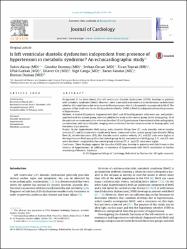| dc.contributor.author | Aksoy, Şükrü | |
| dc.contributor.author | Durmuş, Gündüz | |
| dc.contributor.author | Özcan, Serhan | |
| dc.contributor.author | Toprak, Ercan | |
| dc.contributor.author | Gürkan, Ufuk | |
| dc.contributor.author | Öz, Dilaver | |
| dc.contributor.author | Canga, Yiğit | |
| dc.contributor.author | Karataş, Baran | |
| dc.contributor.author | Duman, Dursun | |
| dc.date.accessioned | 10.07.201910:49:13 | |
| dc.date.accessioned | 2019-07-10T19:57:33Z | |
| dc.date.available | 10.07.201910:49:13 | |
| dc.date.available | 2019-07-10T19:57:33Z | |
| dc.date.issued | 2014 | en_US |
| dc.identifier.citation | Aksoy, Ş., Durmuş, G., Özcan, S., Toprak, E., Gürkan, U., Öz, D. ... Duman, D. (2014). Is left ventricular diastolic dysfunction independent from presence of hypertension in metabolic syndrome? An echocardiographic study. Journal of Cardiology, 64(3-4), 194-198. https://dx.doi.org/10.1016/j.jjcc.2014.01.002 | en_US |
| dc.identifier.issn | 0914-5087 | |
| dc.identifier.issn | 1876-4738 | |
| dc.identifier.uri | https://dx.doi.org/10.1016/j.jjcc.2014.01.002 | |
| dc.identifier.uri | https://hdl.handle.net/20.500.12511/3002 | |
| dc.description | WOS: 000343527100008 | en_US |
| dc.description | PubMed ID: 24525047 | en_US |
| dc.description.abstract | Background: It has been shown that left ventricular diastolic dysfunction (LVDD) develops in patients with metabolic syndrome (MetS). However, there is not sufficient evidence in the literature to determine whether this condition is due to increase in blood pressure, which is frequently encountered in MetS. The purpose of this study was to test the hypothesis whether LVDD in MetS is independent from the presence of hypertension. Methods: A total of 60 patients diagnosed with MetS and 30 healthy people, who were age- and gender-matched with the patient group, were included in the study as the control group. In the study group, 30 of the patients were normotensive whereas the other 30 had hypertension. Conventional echocardiographic examinations and tissue Doppler imaging were performed besides measurements of demographic and biochemical parameters. Results: In the hypertensive MetS group, early diastolic filling flow (E), early diastolic mitral annular velocity (E'), and E/A ratio were significantly lower compared to the control group. Late diastolic filling flow (A), deceleration time (DT), late diastolic mitral annular velocity (A'), and E/E' ratio were higher in the hypertensive MetS group than the control group. In the normotensive MetS group, E, E', and E/A ratio were also lower compared to the control group whereas DT, A', and E/E' ratio were higher. Conclusion: These findings support the idea that LVDD may develop in patients with MetS even in the absence of hypertension. In addition, co-existence of hypertension with MetS contributes to further worsening of diastolic functions. (C) 2014 Japanese College of Cardiology. Published by Elsevier Ltd. All rights reserved. | en_US |
| dc.language.iso | eng | en_US |
| dc.publisher | Elsevier | en_US |
| dc.rights | info:eu-repo/semantics/openAccess | en_US |
| dc.subject | Diastolic Dysfunction | en_US |
| dc.subject | Hypertension | en_US |
| dc.subject | Normotensive | en_US |
| dc.subject | Metabolic Syndrome | en_US |
| dc.title | Is left ventricular diastolic dysfunction independent from presence of hypertension in metabolic syndrome? An echocardiographic study | en_US |
| dc.type | article | en_US |
| dc.relation.ispartof | Journal of Cardiology | en_US |
| dc.department | İstanbul Medipol Üniversitesi, Tıp Fakültesi, Dahili Tıp Bilimleri Bölümü, Kardiyoloji Ana Bilim Dalı | en_US |
| dc.authorid | 0000-0003-2542-3467 | en_US |
| dc.identifier.volume | 64 | en_US |
| dc.identifier.issue | 3-4 | en_US |
| dc.identifier.startpage | 194 | en_US |
| dc.identifier.endpage | 198 | en_US |
| dc.relation.publicationcategory | Makale - Uluslararası Hakemli Dergi - Kurum Öğretim Elemanı | en_US |
| dc.identifier.doi | 10.1016/j.jjcc.2014.01.002 | en_US |
| dc.identifier.wosquality | Q2 | en_US |
| dc.identifier.scopusquality | Q2 | en_US |


















